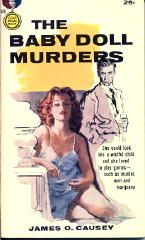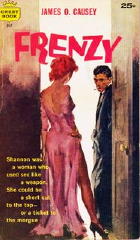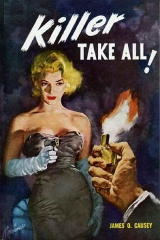Fri 28 Nov 2008
Movie Review – BETRAYAL FROM THE EAST (1945).
Posted by Steve under Reviews , Suspense & espionage films[3] Comments
BETRAYAL FROM THE EAST. RKO Radio Pictures, 1945. Lee Tracy, Nancy Kelly, Richard Loo, Regis Toomey, Philip Ahn, (Victor) Sen Yung, Drew Pearson. Based on the non-fiction book by Alan Hynd. Director: William Berke.

This wartime almost-pure propaganda movie is no longer easy to find. It was released on video cassette but not (so far) on DVD, and the now out-of-print VHS tape (shown) seems to command high prices. I taped my copy from American Movie Classics, sometime B.C. (before commercials), but maybe, just maybe, its staunch anti-Japanese sentiment is part of the reason it seems to have slipped out of sight.
Drew Pearson, one of the most famous newspapermen of the day, appears as himself at the beginning and end of the film, warning heavily against fifth columnists in general and Japanese spies in particular. Considering the relocation camps that Japanese-Americans were forcibly moved to during World War II — but later repudiated in 1980 as “race prejudice, war hysteria, and a failure of political leadership” — it is difficult to view this movie in an purely entertainment mode today.
And in fact, it wasn’t intended to be then, and with the passage of years, it’s certainly not meant to be today. Which is not to say that this movie doesn’t have moments that are worth watching. Nearly ninety minutes long, the film’s production values are a step above the B-movies being made at the same time, and with a little tweaking of the story, dropping Drew Pearson’s role, and tweaking some more, it could have been another Across the Pacific. But they didn’t, and it isn’t.

Lee Tracy as Eddie Carter, now out of the army and low on funds, is tempted by a Japanese friend into making a few dollars, but when he discovers that what’s wanted are plans for defending the Panama Canal, he has second thoughts about what he’s gotten himself into.
Also taking an interest is Peggy Harrison (Nancy Kelly), a slim and pretty brunette who manages to work up an acquaintance with Carter, an acquaintance that quickly becomes more than that.
Tracy was much older than Kelly at the time, 47 to her 24 (and pudgier) and the love affair doesn’t set off any sparks as far as I was concerned, although I could see the attraction she has for him. Even with a couple of nifty plot turns, the whole affair is about as ham-handed as this, made with good intentions at the time, perhaps, but in retrospect, no.





















